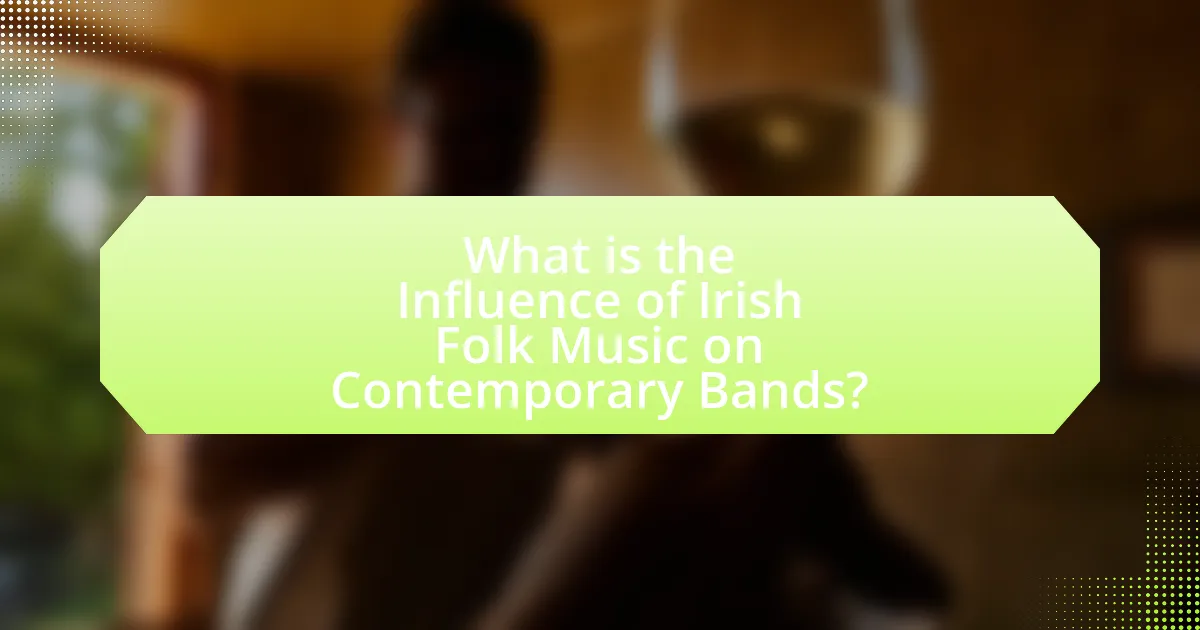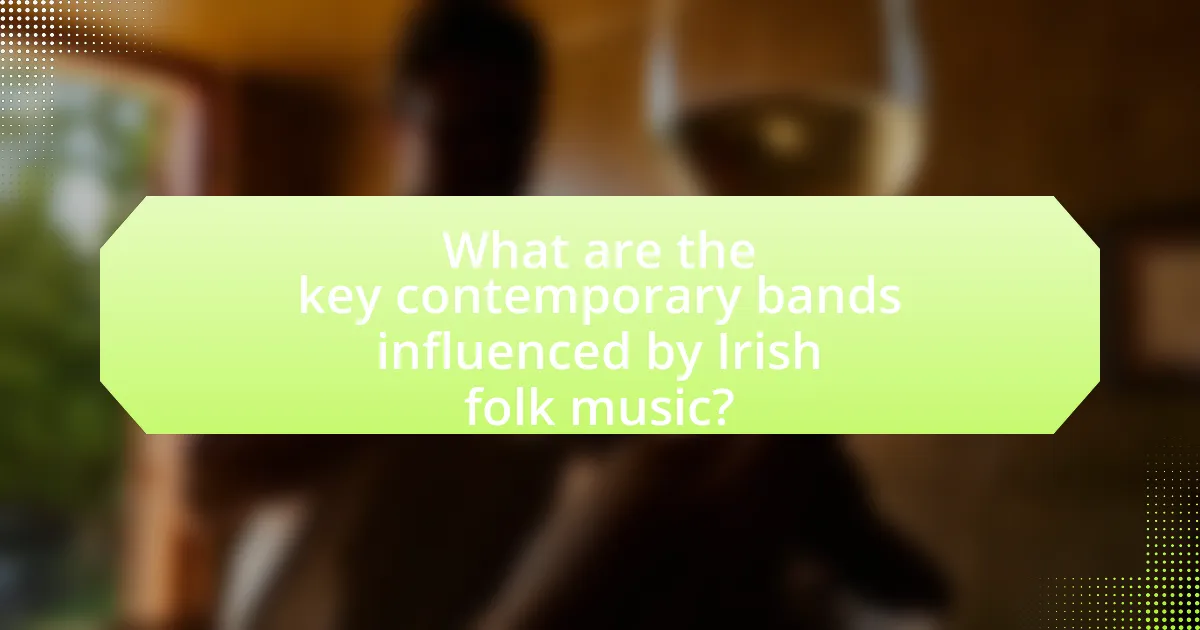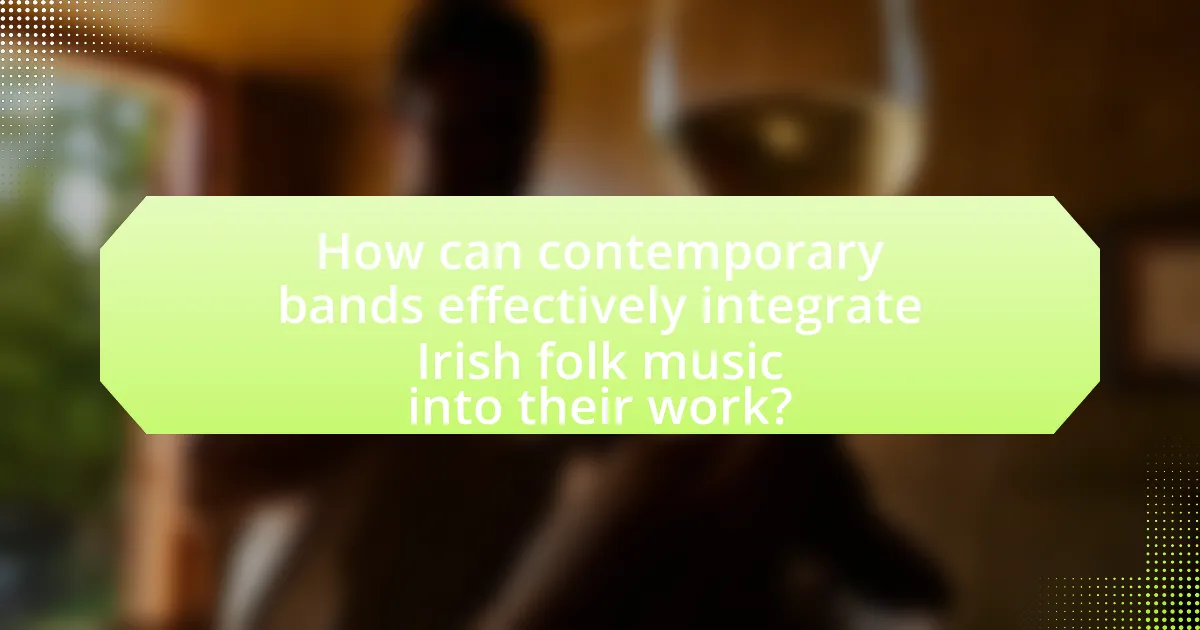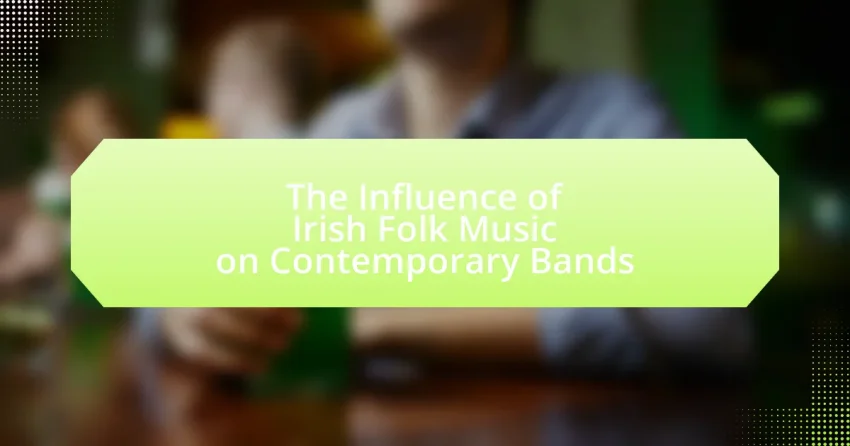The article examines the significant influence of Irish folk music on contemporary bands, highlighting how traditional elements shape modern musical styles, instrumentation, and lyrical themes. It discusses the evolution of Irish folk music from its rural origins to its globalized sound, emphasizing the integration of traditional instruments and storytelling techniques in contemporary compositions. Key contemporary bands such as The Pogues, Flogging Molly, and Mumford & Sons are analyzed for their incorporation of Irish folk elements, showcasing the enduring relevance of this genre in today’s music landscape. The article also addresses the challenges and best practices for bands seeking to blend Irish folk music with modern genres while maintaining authenticity and cultural respect.

What is the Influence of Irish Folk Music on Contemporary Bands?
Irish folk music significantly influences contemporary bands by shaping their musical styles, instrumentation, and lyrical themes. Many contemporary artists incorporate traditional Irish instruments, such as the fiddle, bodhrán, and tin whistle, into their music, creating a fusion of genres that resonates with audiences. For example, bands like The Pogues and Flogging Molly blend punk rock with Irish folk elements, showcasing how traditional melodies and rhythms can enhance modern music. Additionally, the storytelling aspect of Irish folk music inspires contemporary songwriters to explore themes of identity, love, and social issues, reflecting the cultural heritage of Ireland. This influence is evident in the works of artists like Hozier and Ed Sheeran, who draw on folk traditions to create relatable and emotionally charged songs.
How has Irish folk music evolved over time?
Irish folk music has evolved significantly over time, transitioning from traditional rural forms to a more diverse and globalized sound. Initially, Irish folk music was characterized by oral traditions, featuring instruments like the fiddle, tin whistle, and bodhrán, and was primarily performed in local communities. The 20th century saw the emergence of the Irish folk revival, which incorporated influences from rock and pop, leading to the formation of bands like The Dubliners and The Clancy Brothers, who popularized Irish music internationally. This evolution continued with the integration of modern genres, as contemporary bands such as The Pogues and Flogging Molly blended punk rock with traditional Irish elements, showcasing the adaptability and enduring appeal of Irish folk music across various musical landscapes.
What are the key characteristics of traditional Irish folk music?
Traditional Irish folk music is characterized by its use of traditional instruments, distinctive melodies, and a strong emphasis on storytelling. Instruments such as the fiddle, tin whistle, bodhrán, and uilleann pipes are commonly featured, creating a unique sound that is both rhythmic and melodic. The melodies often follow a simple, repetitive structure, making them easy to remember and sing along to. Additionally, the lyrics frequently tell stories of everyday life, history, and folklore, reflecting the cultural heritage of Ireland. This combination of instruments, melodies, and storytelling elements has influenced many contemporary bands, integrating traditional Irish themes into modern music styles.
How did historical events shape the development of Irish folk music?
Historical events significantly shaped the development of Irish folk music by influencing its themes, styles, and instruments. The Great Famine of the 1840s, for instance, led to mass emigration, which spread Irish musical traditions globally, incorporating elements from other cultures and creating hybrid forms. Additionally, the Irish War of Independence and subsequent civil conflict in the early 20th century inspired songs that reflected national identity and resistance, embedding political narratives into the folk repertoire. The revival movements in the 1960s, spurred by a renewed interest in cultural heritage, further solidified traditional music’s role in Irish society, leading to its integration into contemporary bands and global music scenes.
Why is Irish folk music significant in contemporary music?
Irish folk music is significant in contemporary music because it has profoundly influenced various genres and artists, enriching their sound and cultural narratives. The incorporation of traditional Irish instruments, such as the fiddle and bodhrán, alongside contemporary styles has created a unique fusion that resonates with audiences globally. For instance, bands like The Pogues and Flogging Molly blend punk rock with Irish folk elements, showcasing how this genre can enhance lyrical storytelling and emotional depth. Additionally, the revival of interest in Irish folk music has led to collaborations with mainstream artists, further solidifying its relevance in today’s music scene.
What cultural elements from Irish folk music are prevalent in modern bands?
Cultural elements from Irish folk music prevalent in modern bands include traditional instruments, storytelling lyrics, and rhythmic patterns. Many contemporary bands incorporate instruments such as the fiddle, tin whistle, and bodhrán, which are staples of Irish folk music. Additionally, the narrative style of lyrics often reflects themes of love, loss, and community, mirroring the storytelling tradition found in Irish folk songs. The use of lively jigs and reels as rhythmic foundations also influences the tempo and energy of modern compositions, creating a fusion that resonates with audiences. This blending of traditional elements with contemporary styles showcases the enduring impact of Irish folk music on today’s musical landscape.
How does Irish folk music influence lyrical themes in contemporary songs?
Irish folk music significantly influences lyrical themes in contemporary songs by incorporating storytelling, cultural identity, and emotional depth. Contemporary artists often draw from the rich narrative tradition of Irish folk, which emphasizes personal and communal experiences, as seen in songs by bands like The Pogues and Flogging Molly. These artists utilize themes of love, loss, and social issues, mirroring the lyrical content found in traditional Irish ballads. For instance, the song “Fairytale of New York” by The Pogues reflects the struggles and aspirations of Irish immigrants, showcasing how historical context shapes modern narratives. This blending of past and present not only preserves cultural heritage but also resonates with a global audience, demonstrating the enduring relevance of Irish folk music in contemporary songwriting.

What are the key contemporary bands influenced by Irish folk music?
Key contemporary bands influenced by Irish folk music include The Pogues, Flogging Molly, and Mumford & Sons. The Pogues, formed in 1982, are known for their fusion of traditional Irish music with punk rock, exemplified in songs like “Fairytale of New York.” Flogging Molly, established in 1997, blends Celtic influences with punk, evident in tracks such as “Drunken Lullabies.” Mumford & Sons, while primarily a folk rock band, incorporates elements of Irish folk in their instrumentation and melodies, as seen in their hit “I Will Wait.” These bands demonstrate the enduring impact of Irish folk music on contemporary genres.
Which bands have explicitly incorporated Irish folk elements into their music?
The bands that have explicitly incorporated Irish folk elements into their music include The Pogues, Flogging Molly, and Dropkick Murphys. The Pogues are known for blending traditional Irish music with punk rock, particularly in their iconic song “Fairytale of New York,” which features traditional Irish instrumentation and themes. Flogging Molly combines Celtic influences with punk rock, evident in tracks like “Drunken Lullabies,” which showcases traditional Irish melodies and rhythms. Dropkick Murphys also fuse punk rock with Irish folk, as seen in their song “Shipping Up to Boston,” which incorporates traditional Irish instruments and themes. These bands exemplify the integration of Irish folk elements into contemporary music, demonstrating the genre’s lasting influence.
What specific instruments from Irish folk music are used by these bands?
Irish folk music bands commonly use instruments such as the fiddle, tin whistle, bodhrán, accordion, and uilleann pipes. The fiddle serves as a primary melodic instrument, while the tin whistle adds a distinct high-pitched sound. The bodhrán, a traditional frame drum, provides rhythmic support, and the accordion contributes harmonic depth. Uilleann pipes, known for their unique sound, are often featured in more traditional arrangements. These instruments are integral to the genre, reflecting the rich cultural heritage of Irish music and its influence on contemporary bands.
How do these bands blend traditional and modern musical styles?
These bands blend traditional and modern musical styles by incorporating traditional Irish instruments and melodies into contemporary genres such as rock, pop, and folk. For example, bands like The Pogues and Flogging Molly utilize instruments like the tin whistle and accordion alongside electric guitars and modern percussion, creating a fusion that appeals to both traditional folk music enthusiasts and modern listeners. This blending is evident in their song structures, which often feature traditional Irish rhythms and scales while employing contemporary production techniques and lyrical themes relevant to today’s audience.
What are some notable examples of songs that reflect this influence?
Notable examples of songs that reflect the influence of Irish folk music on contemporary bands include “The Foggy Dew” by The Chieftains featuring Sinead O’Connor, “Galway Girl” by Steve Earle, and “The Parting Glass” as performed by The High Kings. These songs incorporate traditional Irish melodies, instrumentation, and lyrical themes, showcasing the enduring impact of Irish folk music on modern musical expressions. For instance, “Galway Girl” blends folk elements with contemporary pop, achieving significant commercial success and highlighting the cultural crossover.
How do these songs showcase the characteristics of Irish folk music?
These songs showcase the characteristics of Irish folk music through their use of traditional instruments, storytelling lyrics, and communal singing. Traditional instruments such as the fiddle, tin whistle, and bodhrán create a distinctive sound that is emblematic of Irish folk music. The lyrics often tell stories of love, loss, and historical events, reflecting the cultural heritage and emotional depth typical of the genre. Additionally, the emphasis on communal singing encourages participation and fosters a sense of community, which is a hallmark of Irish folk traditions. These elements collectively highlight the enduring influence of Irish folk music on contemporary bands, as they incorporate these characteristics into their own musical expressions.
What themes or stories do these songs convey that are rooted in Irish culture?
Irish folk songs convey themes of love, loss, emigration, and the struggles of everyday life, deeply rooted in the historical and cultural experiences of the Irish people. These songs often tell stories of longing for home, reflecting the impact of the Great Famine and subsequent waves of emigration, where individuals express their yearning for their homeland and the pain of separation. Additionally, many songs celebrate Irish identity and heritage, incorporating elements of folklore, mythology, and the natural landscape, which serve to preserve cultural narratives and foster a sense of community. The historical context of these themes is evident in songs like “The Fields of Athenry,” which narrates the plight of a man during the Famine, illustrating the intersection of personal and collective experiences in Irish culture.

How can contemporary bands effectively integrate Irish folk music into their work?
Contemporary bands can effectively integrate Irish folk music into their work by incorporating traditional instruments, melodies, and storytelling techniques characteristic of the genre. For instance, using instruments like the fiddle, bodhrán, and tin whistle can create an authentic sound that resonates with Irish folk traditions. Additionally, contemporary bands can adapt traditional Irish melodies into modern arrangements, blending them with contemporary genres such as rock or pop, which has been successfully demonstrated by bands like The Pogues and Flogging Molly. Furthermore, integrating themes of Irish folklore and history into lyrics can enhance the cultural depth of the music, as seen in the works of artists like Hozier, who often draw on Irish heritage in their songwriting. This approach not only preserves the essence of Irish folk music but also introduces it to new audiences, ensuring its continued relevance in modern music.
What techniques can bands use to incorporate Irish folk elements?
Bands can incorporate Irish folk elements by utilizing traditional instruments, employing specific musical scales, and integrating folk storytelling techniques. Traditional instruments such as the fiddle, tin whistle, and bodhrán create authentic sounds characteristic of Irish folk music. Additionally, using the Dorian and Mixolydian scales, which are prevalent in Irish melodies, enhances the folk feel of the music. Furthermore, integrating narrative lyrics that reflect Irish folklore or personal stories can deepen the connection to the cultural roots of Irish folk traditions. These techniques collectively enrich contemporary music with the essence of Irish folk heritage.
How can bands choose the right instruments to reflect Irish folk influences?
Bands can choose the right instruments to reflect Irish folk influences by incorporating traditional instruments such as the fiddle, tin whistle, bodhrán, and uilleann pipes. These instruments are integral to Irish folk music, providing authentic sound and cultural resonance. For example, the fiddle is often used in traditional Irish jigs and reels, while the bodhrán adds rhythmic depth. The use of these instruments not only enhances the authenticity of the music but also connects the band to the rich history and cultural heritage of Ireland, which is essential for accurately representing Irish folk influences in contemporary music.
What role do collaborations with traditional Irish musicians play in this integration?
Collaborations with traditional Irish musicians play a crucial role in the integration of Irish folk music into contemporary bands by enriching their sound and authenticity. These partnerships allow modern artists to incorporate traditional instruments, melodies, and rhythms, which enhances the cultural depth of their music. For instance, bands like The Chieftains have successfully collaborated with various contemporary artists, bridging the gap between traditional and modern genres, thus demonstrating how these collaborations can lead to innovative musical fusions that resonate with diverse audiences. This blending not only preserves the heritage of Irish music but also introduces it to new listeners, ensuring its continued relevance in the evolving music landscape.
What are the challenges faced when blending Irish folk music with contemporary genres?
Blending Irish folk music with contemporary genres presents challenges such as maintaining cultural authenticity while appealing to modern audiences. The distinct musical structures and traditional instruments of Irish folk can clash with the production techniques and stylistic elements of contemporary genres like pop or rock. Additionally, artists may struggle to balance the storytelling aspect inherent in folk music with the more abstract themes often found in contemporary music. This tension can lead to a dilution of the original folk sound, risking alienation of traditionalists. Furthermore, the commercial pressures of contemporary music can overshadow the artistic integrity of folk traditions, complicating the fusion process.
How can bands overcome cultural appropriation concerns while honoring the tradition?
Bands can overcome cultural appropriation concerns while honoring tradition by engaging in authentic collaboration with cultural representatives and ensuring respectful representation. This approach allows bands to incorporate elements of Irish folk music while acknowledging its origins and significance. For instance, collaborating with Irish musicians can provide insights into the cultural context and nuances of the music, fostering a genuine connection. Additionally, educating themselves about the history and meaning behind the traditions they draw from can help bands avoid misrepresentation. Research indicates that artists who actively involve cultural communities in their creative processes are more likely to be viewed as respectful and appreciative rather than appropriative, thus maintaining the integrity of the tradition while expanding their musical repertoire.
What strategies can bands employ to maintain authenticity in their music?
Bands can maintain authenticity in their music by staying true to their cultural roots and incorporating traditional elements into their sound. This strategy involves blending contemporary styles with authentic Irish folk instruments, melodies, and storytelling techniques, which can resonate with audiences while preserving the essence of the genre. For instance, bands like The High Kings and The Chieftains have successfully integrated traditional Irish instruments such as the bodhrán and fiddle into modern arrangements, showcasing their heritage while appealing to a broader audience. This approach not only honors the musical traditions but also fosters a genuine connection with listeners who appreciate the cultural significance behind the music.
What best practices should contemporary bands follow when drawing from Irish folk music?
Contemporary bands should prioritize authenticity and respect for the cultural roots of Irish folk music when drawing from it. This involves thorough research into the history, themes, and traditional instruments associated with Irish folk music, ensuring that the essence of the genre is preserved. For instance, using traditional instruments like the fiddle, bodhrán, and tin whistle can enhance the authenticity of the sound. Additionally, bands should collaborate with traditional Irish musicians to gain insights and techniques that enrich their interpretations. Engaging with the community and participating in folk music events can also foster a deeper understanding and appreciation of the genre, leading to more genuine and respectful adaptations.
